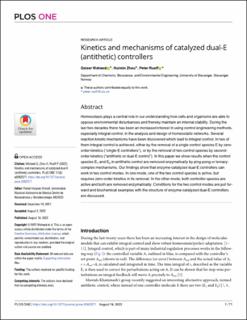| dc.contributor.author | Waheed, Qaiser | |
| dc.contributor.author | Zhou, Huimin | |
| dc.contributor.author | Ruoff, Peter | |
| dc.date.accessioned | 2023-03-21T10:28:07Z | |
| dc.date.available | 2023-03-21T10:28:07Z | |
| dc.date.created | 2022-08-19T09:00:02Z | |
| dc.date.issued | 2022 | |
| dc.identifier.citation | Waheed, Q., Zhou, H., & Ruoff, P. (2022). Kinetics and mechanisms of catalyzed dual-E (antithetic) controllers. PloS one, 17(8), e0262371. | en_US |
| dc.identifier.issn | 1932-6203 | |
| dc.identifier.uri | https://hdl.handle.net/11250/3059487 | |
| dc.description.abstract | Homeostasis plays a central role in our understanding how cells and organisms are able to oppose environmental disturbances and thereby maintain an internal stability. During the last two decades there has been an increased interest in using control engineering methods, especially integral control, in the analysis and design of homeostatic networks. Several reaction kinetic mechanisms have been discovered which lead to integral control. In two of them integral control is achieved, either by the removal of a single control species E by zero-order kinetics (“single-E controllers”), or by the removal of two control species by second-order kinetics (“antithetic or dual-E control”). In this paper we show results when the control species E1 and E2 in antithetic control are removed enzymatically by ping-pong or ternary-complex mechanisms. Our findings show that enzyme-catalyzed dual-E controllers can work in two control modes. In one mode, one of the two control species is active, but requires zero-order kinetics in its removal. In the other mode, both controller species are active and both are removed enzymatically. Conditions for the two control modes are put forward and biochemical examples with the structure of enzyme-catalyzed dual-E controllers are discussed. | en_US |
| dc.language.iso | eng | en_US |
| dc.publisher | PLOS | en_US |
| dc.rights | Navngivelse 4.0 Internasjonal | * |
| dc.rights.uri | http://creativecommons.org/licenses/by/4.0/deed.no | * |
| dc.title | Kinetics and mechanisms of catalyzed dual-E (antithetic) controllers | en_US |
| dc.type | Peer reviewed | en_US |
| dc.type | Journal article | en_US |
| dc.description.version | publishedVersion | en_US |
| dc.rights.holder | the authors | en_US |
| dc.subject.nsi | VDP::Matematikk og Naturvitenskap: 400::Basale biofag: 470 | en_US |
| dc.source.volume | 17 | en_US |
| dc.source.journal | PLOS ONE | en_US |
| dc.source.issue | 8 | en_US |
| dc.identifier.doi | 10.1371/journal.pone.0262371 | |
| dc.identifier.cristin | 2044385 | |
| dc.source.articlenumber | e0262371 | en_US |
| cristin.ispublished | true | |
| cristin.fulltext | original | |
| cristin.qualitycode | 1 | |

